I love exploring North African cuisine, and Moroccan couscous is a favorite. Its fluffy grains and spices take me to Morocco’s markets and family gatherings. Every bite reminds me of the dish’s cultural importance and the care in making it.
In this guide, I’ll show you how to make Moroccan couscous like a pro. We’ll cover its history, the right ingredients, and how to prepare it perfectly. You’ll learn to make this North African favorite in your kitchen.
Table of Contents
Understanding the Cultural Significance of Moroccan Couscous
Moroccan couscous is more than a tasty dish; it’s a cultural symbol deeply rooted in Moroccan society. It comes from the Berber cuisine of North Africa. Over time, it has become a key part of Moroccan food culture.
Origins and Historical Development
The story of couscous starts with the Berber people. They are thought to have first made this dish from grains. As Moroccan cooking traditions grew, couscous became a key part of Berber cuisine. It shows the region’s rich farming and food history.
Role in Moroccan Family Traditions
In Moroccan homes, couscous is very special. It brings families together. Making and sharing couscous is a family activity that spans generations.
Preparing couscous is a tradition passed down through the years. Eating it is a sacred act that strengthens family ties.
Regional Variations Across Morocco
In Morocco, couscous varies by region, showing the country’s cultural and culinary diversity. From the Rif Mountains’ saffron couscous to the High Atlas’s vegetable-rich versions, each area has its own twist. These variations highlight the richness of Moroccan food culture.
Essential Ingredients for Traditional Moroccan Couscous
Making a real Moroccan couscous starts with the right ingredients. At its core is semolina wheat. This is what makes couscous so special, giving it its unique texture and shape.
You’ll also need Moroccan spices to bring the dish to life. Spices like cumin, cinnamon, ginger, and paprika are key. They add a rich, complex flavor to the couscous.
To round out the dish, add fresh vegetables like carrots, zucchini, and onions. They not only make the dish healthier but also balance out the flavors. For a more filling meal, consider adding halal meat like lamb or chicken. This adds a nice protein boost.
| Ingredient | Purpose |
|---|---|
| Semolina Wheat | The foundation of couscous, providing the signature texture |
| Moroccan Spices (Salt, Cinnamon, Ginger, Pepper, Turmeric, Smen) | Infusing the couscous with the rich, aromatic flavors of Moroccan cuisine |
| Fresh Vegetables (Carrots, Zucchini, Onions, Tomatoes, Chickpeas, Parsley and cilantro sprigs, acorn squash, quartered – (or wedge of pumpkin), Medium turnips, peeled and cut in half, head of cabbage) | Adding nutrition, balance, and complementary flavors to the dish |
| Halal Meat (Lamb, Chicken) | Providing a satisfying protein element to the couscous |
For a true Moroccan couscous experience, use the best, freshest ingredients. With semolina, spices, vegetables, and meat, you’ll make a dish that truly captures Moroccan tradition.
Traditional Cooking Equipment and Tools Needed
Preparing authentic Moroccan couscous requires the right tools. At the heart of the Moroccan kitchen is the couscoussier. It’s a special steamer pot key to making couscous.
The Couscoussier: Your Essential Cooking Vessel
The couscoussier is a two-piece pot. It has a large bottom for simmering and a top with holes for the couscous. Steam cooks the couscous to fluffy perfection.
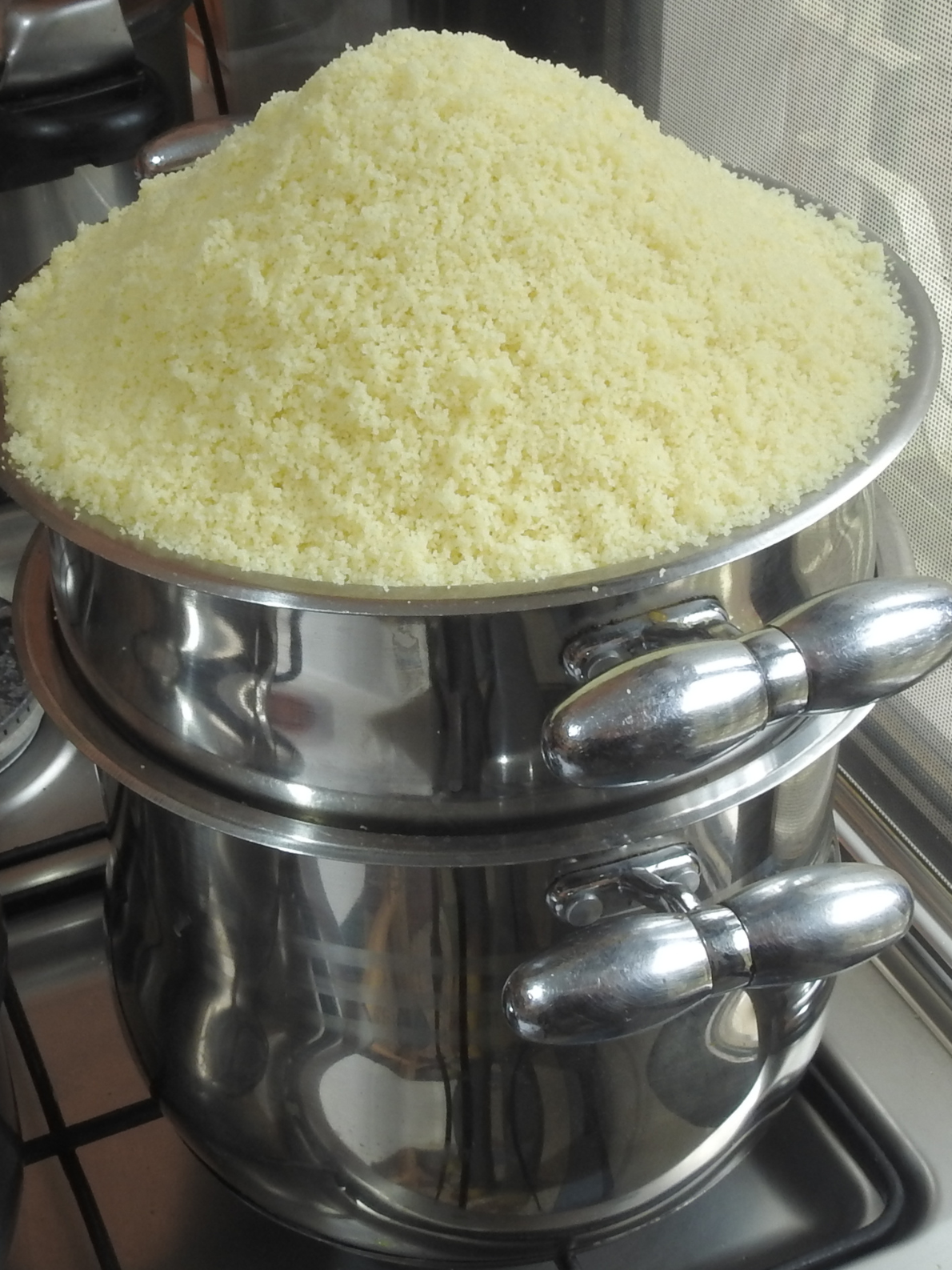
Additional Kitchen Tools for Preparation
- Couscous server : A shallow dish for serving couscous.
- Wooden spoon : For stirring the couscous.
Modern Alternatives to Traditional Equipment
While the couscoussier is preferred, modern cooks might not have it. A steamer pot or a large pot with a colander works as a substitute. The goal is to mimic the two-layer cooking process.
Dive into the world of Moroccan cuisine with this meticulously crafted ingredients table. Each column will guide you through the essentials to prepare this delicious dish in the most flavorful way possible.
| Ingredient | Preparation | Optimal Season |
|---|---|---|
| Couscous (2.2 lb.) | Choose medium-grain, non-instant couscous. Coat with oil before steaming and fluff it for a perfect texture. | All-year round |
| Olive Oil (1/4 cup) | Use high-quality, extra-virgin olive oil to enhance the couscous and broth flavors. | Fall and winter |
| Water (6 cups) | For steaming, and optionally replace the final cup with milk for a creamier taste. | All-year round |
| Salt (2-3 tsp) | Add after the first steaming for balanced seasoning. | All-year round |
| Soft Butter (2 tbsp) | Add to the couscous during the final steaming to achieve a rich, velvety finish. | All-year round |
| Meat (2.2 lb.) | Choose lamb, beef, goat, or chicken with bones for authentic Moroccan taste. | Winter (hearty meals) |
| Fresh Tomatoes (3) | Peel, chop, and cook them into the broth base for rich depth. | Summer (peak ripeness) |
| Spices (ginger, turmeric, pepper, salt) | Essential for the broth to bring out the signature Moroccan flavor. | All-year round |
| Parsley & Cilantro (1 handful) | Tie into a bouquet to infuse the broth with aromatic freshness. | Spring and summer |
| Smen (2 tsp) | Optional Moroccan preserved butter for authentic umami. | All-year round |
| Dried Chickpeas (1/2 cup) | Soak overnight before adding to the broth. | All-year round |
| Cabbage (1 small) | Quarter for ease of cooking; infuse the broth with its hearty sweetness. | Winter |
| Turnips (3–4) | Peel and halve before adding to the broth for earthy flavors. | Winter |
| Carrots (8–10) | Halve if large; add early for natural sweetness. | Spring and summer |
| Pumpkin or Acorn Squash | Cut into large wedges to maintain texture during cooking. | Fall |
| Zucchini (4–5) | Halve round varieties; add later to avoid overcooking. | Summer |
| Optional Vegetables | Jalapeños, fava beans, sweet potatoes, or bottle gourd for added variation. | Based on availability |
| Raisins (1/2 cup) | Soak in water for 15 minutes before caramelizing for tfaya. | All-year round |
| Red Onions (2–3) | Slice thin for the optional tfaya topping. | Fall |
| Honey (2 tbsp) | Adds sweetness to the tfaya, balancing the savory dish. | All-year round |
| Cinnamon & Saffron | Infuse the tfaya with warm, fragrant notes. | All-year round |
Discover More About Moroccan Couscous
Why Is Moroccan Couscous Special?
Moroccan couscous is a delicate blend of flavors, textures, and centuries-old traditions. This dish is not just a meal; it’s a celebration of Moroccan culture and hospitality. Learn more about its cultural significance here.
Tips for the Best Moroccan Couscous
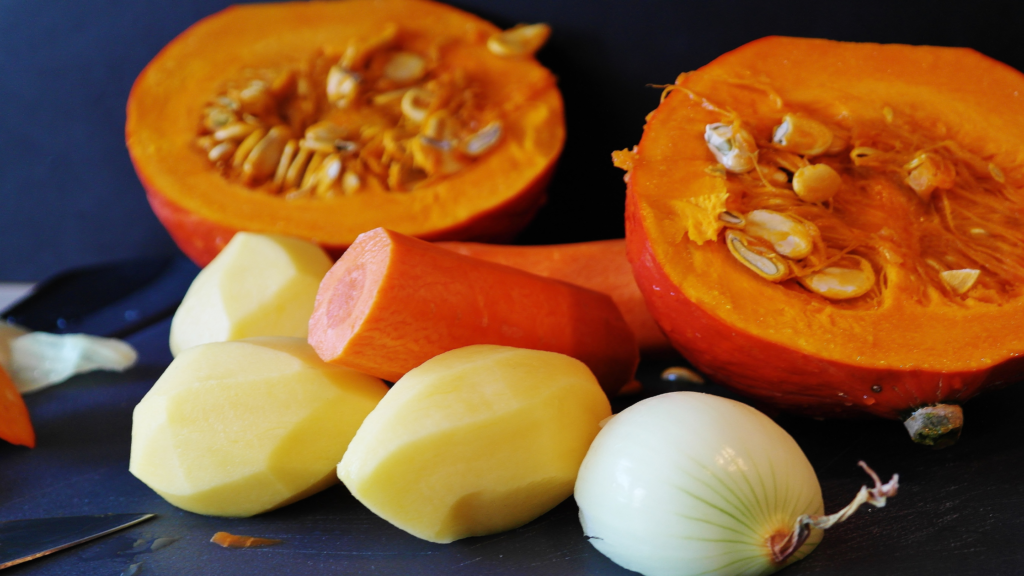
- Steaming is Key: Avoid instant couscous for an authentic experience. Steam it thrice for light, fluffy grains.
- Use Fresh Spices: High-quality spices ensure the deep, aromatic flavors Moroccan cuisine is known for. Shop Moroccan spices.
- Seasonal Veggies: Adjust the vegetables according to the season for optimal taste and texture.
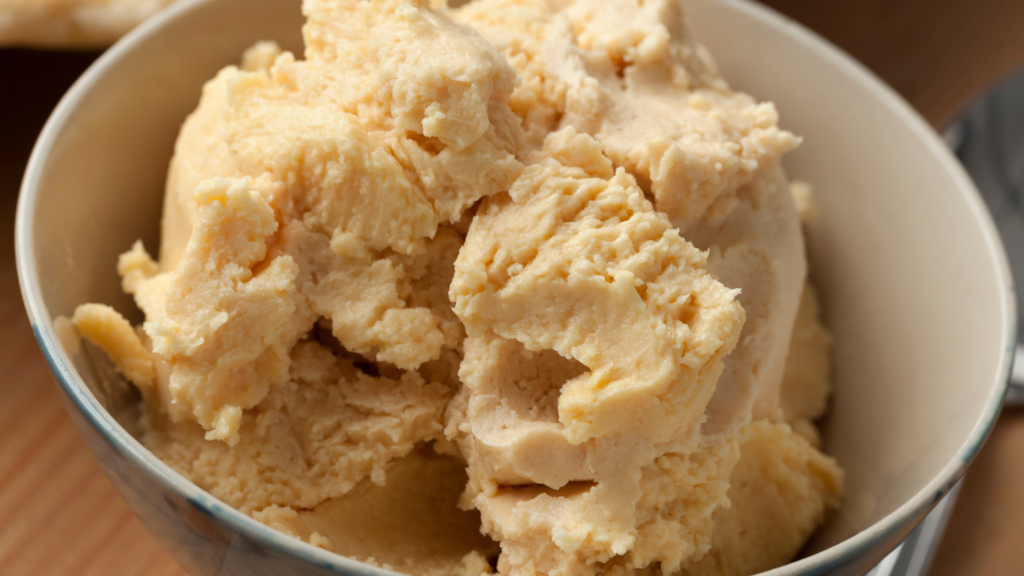
Crafting the perfect Moroccan couscous takes love, patience, and attention to detail. Explore more tips and recipes on our Moroccan Section.
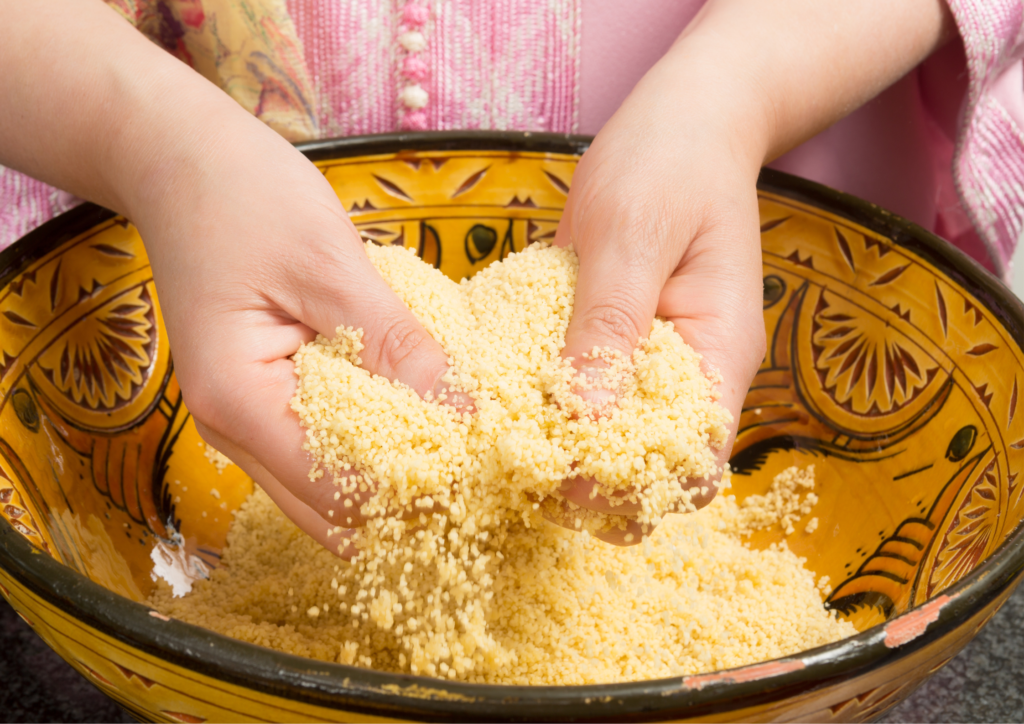
Fluffing for Flawless Texture
After steaming, fluff the couscous. Use a fork or your hands to separate the grains. This step keeps the couscous light and fluffy.
Perfecting the Semolina Preparation
Semolina, the granular durum wheat, is crucial in Moroccan couscous. Rinse the semolina and toast it lightly in a skillet. This brings out its nutty flavor and aroma.
Mastering couscous steaming, fluffing, and semolina preparation will make your Moroccan couscous a hit. It’s sure to impress your taste buds.
Selecting and Preparing Seasonal Vegetables
Moroccan cuisine is famous for its colorful, tasty vegetables. These are picked and prepared to go well with couscous. To make authentic Moroccan couscous, knowing about seasonal produce and how to cut vegetables is crucial.
Root Vegetables in Moroccan Cuisine
Root vegetables are key in Moroccan couscous. They add depth, texture, and nutrition. Carrots, turnips, parsnips, and potatoes are common. They make the couscous rich and comforting.
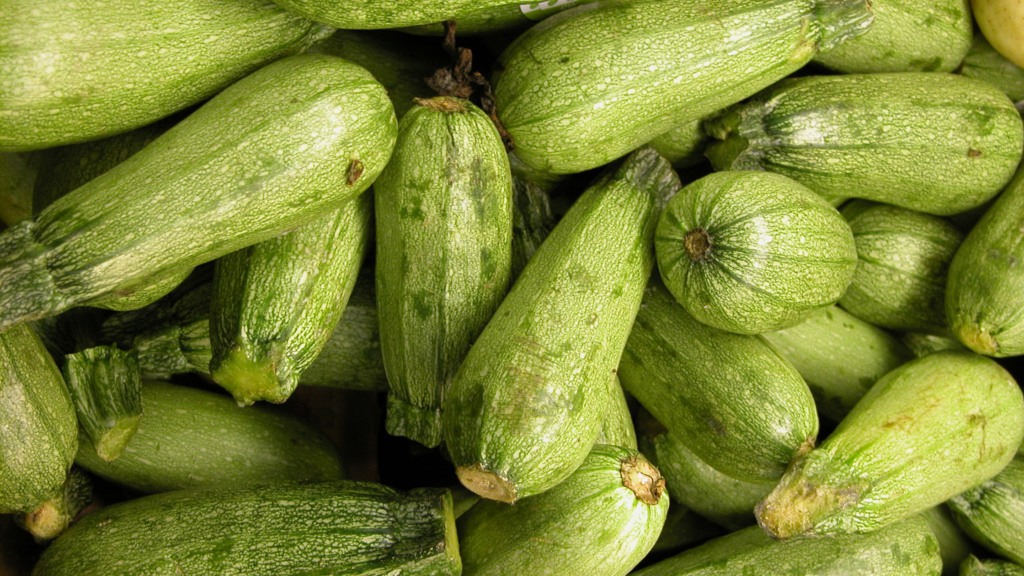
Proper Cutting and Sizing Techniques
Cutting vegetables right is important for even cooking and flavors in Moroccan couscous. Cut your Moroccan vegetables into 1-inch cubes. This ensures they cook evenly and look good together.
Seasonal Vegetable Combinations
Moroccan couscous is great for showing off local produce. Try different root vegetable preparation and vegetable cutting techniques for new tastes. Use seasonal favorites like zucchini, bell peppers, and pumpkin for color and texture.
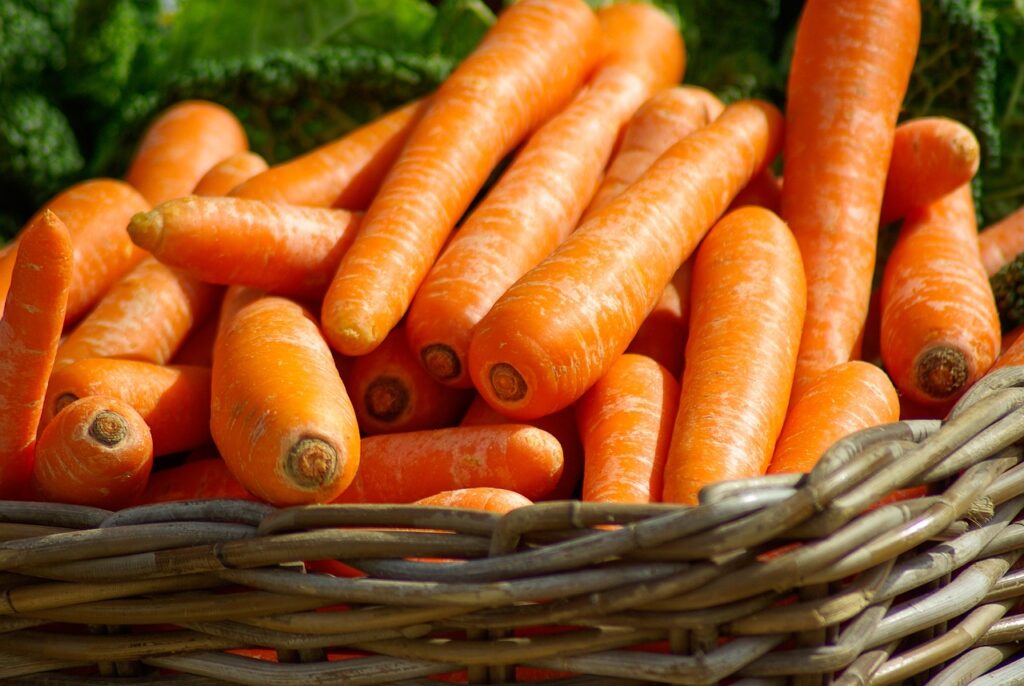
Step-by-Step Cooking Method for Authentic Results
Learning the traditional steaming method is key to perfect Moroccan couscous. This method adds unmatched flavor and keeps the couscous light and fluffy. It’s what makes couscous so special in Moroccan cooking.
Steam and Fluff Technique
Start by steaming the couscous grains in a couscoussier or a pot with a steamer insert. Use a fork or your hands to gently fluff the couscous. This helps the steam spread evenly, making the couscous light and fluffy.
Layering Ingredients for Optimal Flavor
To get the real Moroccan couscous taste, layer the ingredients in the couscoussier or steamer. Start with the couscous grains at the bottom. Then, add the seasoned vegetables, meats, or other toppings, making sure each layer is even.
This way, the flavors mix well and the couscous absorbs the Moroccan spices and ingredients.
Timing and Temperature Control
Cooking Moroccan couscous needs patience. Keep the steam temperature steady and watch the cooking time. This ensures the couscous is cooked right but still soft.
Adjust the heat as needed to avoid overcooking or drying out the couscous.
By following these tips, you can enjoy the real flavors and aromas of Moroccan couscous at home. Use the traditional steaming method, layer your ingredients carefully, and let the couscous cook perfectly for a memorable Moroccan meal.
Traditional Serving Suggestions and Presentation
Serving Moroccan couscous is all about tradition and presentation. The way you serve it can make the dining experience even better. Choose ornate, handcrafted tagines or decorative platters to showcase Moroccan cuisine.
Place the steaming couscous in the center of the table. Surround it with braised vegetables and tender meats. Add vibrant herbs, toasted almonds, and a drizzle of aromatic olive oil. This presentation is not only beautiful but also lets guests enjoy the authentic Moroccan experience.
Moroccan dining is a communal affair. Encourage guests to gather around the table and use their hands to scoop up couscous. Provide small plates or bowls for everyone. Don’t forget to offer traditional accompaniments like harissa, preserved lemons, and mint tea.
FAQ
What is the cultural significance of Moroccan couscous?
Moroccan couscous is deeply rooted in North African Berber cuisine. It’s a key dish in Moroccan family traditions. It’s often served at celebrations and special events.
What are the essential ingredients for traditional Moroccan couscous?
Essential ingredients include semolina wheat, seasonal veggies like carrots and zucchini, and chickpeas.
What type of cooking equipment is used for preparing Moroccan couscous?
Traditionally, a couscoussier is used. It’s a two-part pot with a steamer insert. But, you can also use a steamer pot or a multi-tiered vegetable steamer.
How do you prepare the perfect couscous base?
Start by washing and steaming the semolina grains. This makes them light and fluffy. It’s a key step for authentic Moroccan couscous.
What is the traditional cooking method for Moroccan couscous?
The traditional method involves steaming and fluffing the couscous. It’s layered with veggies and meats. This process is crucial for the right texture and flavor.
How is Moroccan couscous traditionally served and presented?
It’s served in a communal dish, with grains in a mound. The dish is surrounded by stewed veggies and proteins. Traditional serving dishes add to the experience.

